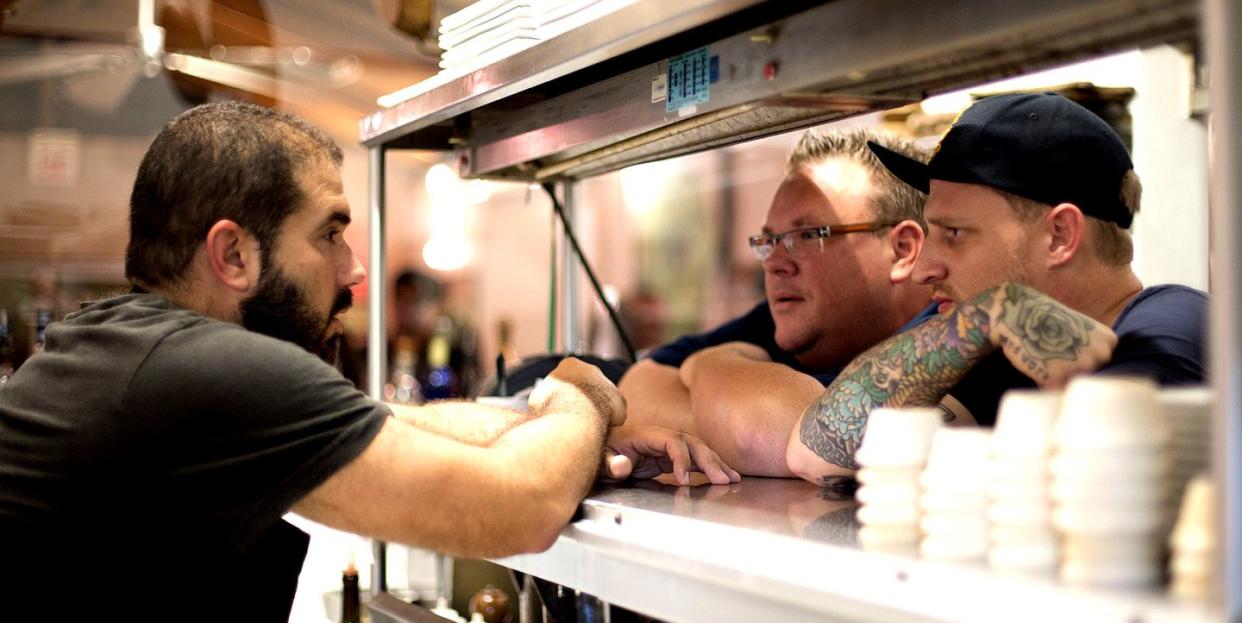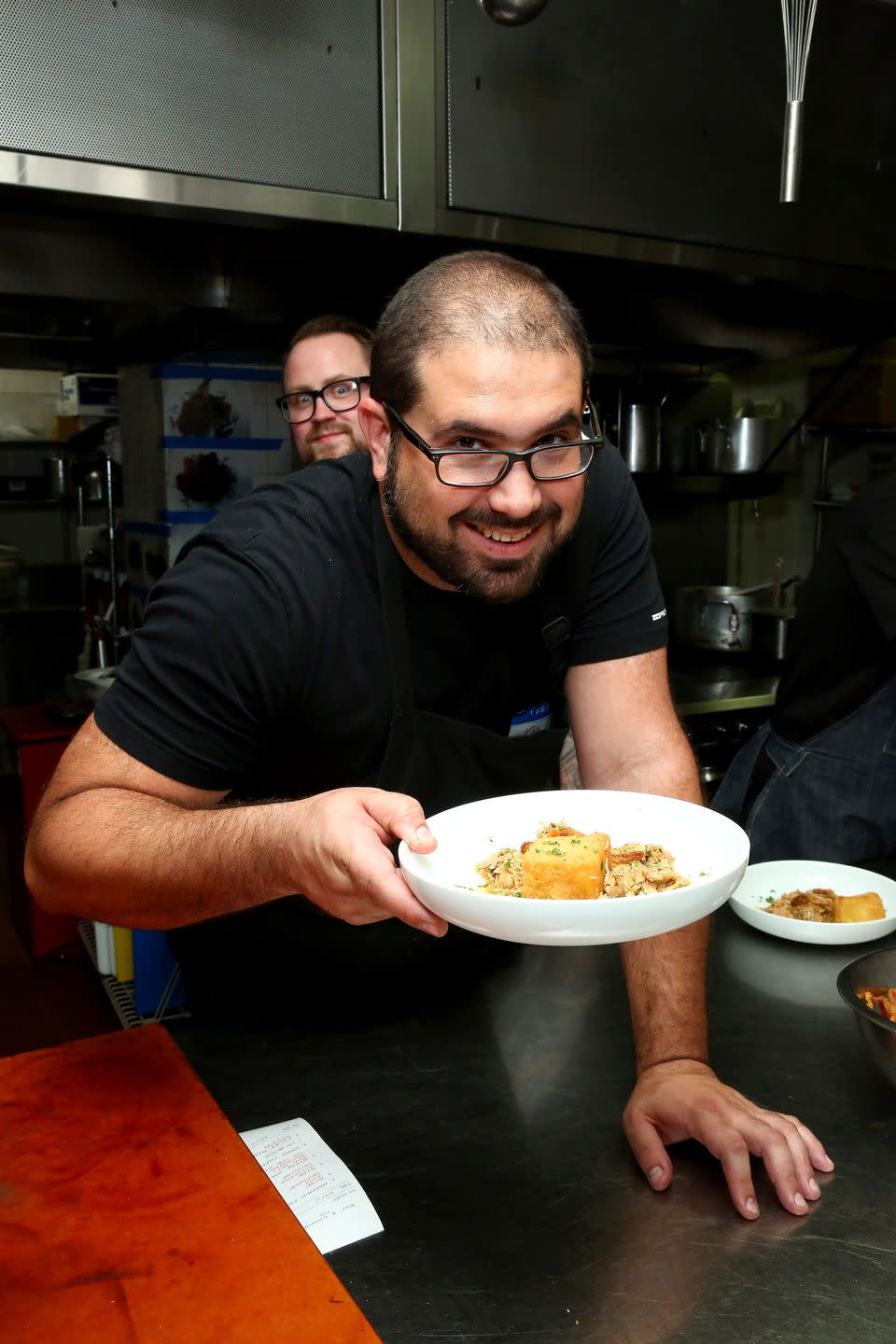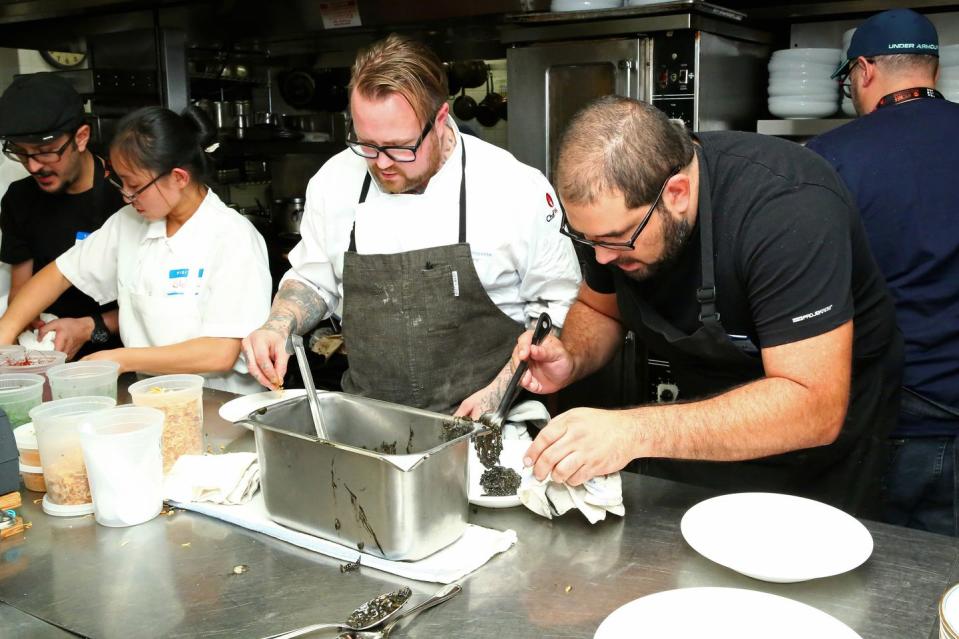Jose Enrique on Cooking in Puerto Rico After Maria

If you happen to be in the Santurce neighborhood of San Juan, Puerto Rico, around 4 in the afternoon, stop by Jose Enrique's restaurant. If you time it just right, there won't be a line out the door, and the white board that serves as a menu won't have eraser streaks that signal the kitchen's run out of its best dishes.
Unmarked, bright pink, and smaller than a gas station lobby off a Midwest turnpike, his restaurant is that popular-but not at the expense of keeping that Puerto Rican spirit alive. People ask Enrique, "Wait, I can just sit down and be here for three hours talking shit and listening to music?" And he responds, "Yeah, you can! It's cool!"
Enrique champions locally grown food. On a good day, his menu is made of 75 percent local produce and meat, "which is like the day you cry-holy shit, my menu's almost all local-you're bawling," he says.
But the last half year has been as, Enrique says over and over, "tough."

Tough is an understatement. First, there was Hurricane Irma, which brushed the island and left people without power and reliant on whatever food they'd stored. Then came Maria, a Category 5 storm that decimated Puerto Rico-buildings are still covered in tarps and communities are still without electricity and water almost eight months later. Maria took the roof and windows from Enrique's restaurant. But he had gas to run a generator and power the kitchen. He made huge batches of hearty sancocho, a local soup with roots, tubers, and meat. He had pineapples, so he made pineapple and sesame seed salsa served over cod fritters.
"I called all my friends and family like, 'Dude, stop by, I've got food. You can eat and take some home,'" he says. He invited the community in. Two days later, celebrity chef José Andrés of World Central Kitchen called and announced he was coming down. He set up shop at Enrique's and started marshaling chefs and volunteers to feed Puerto Rico.
"The next day it was like, oh shit, we just did 3,000 meals. The next day we did 7,ooo-all right-and then we did 14,000, and I'm like, what's going on here? It just kept growing," Enrique says.
The operation grew to 20,000 meals a day, Enrique says; it outgrew the space in a week. Andrés moved out to a space better equipped to hold his team. Enrique got ready to reopen as a restaurant to get his and his employees' lives back on track. Then, an hour before he opened his doors, the generator blew, and a 50-day stretch of powerlessness began.
Over daiquiris and Don Q Gold rum at his restaurant, seven months after the storm, Enrique told me about reopening the restaurant, serving local food, and why now's the time to visit Puerto Rico.
Being closed for 50 days was enough to make him crazy.
You try and just do whatever you can as far as helping the community. If I'm a knee surgeon, maybe there's just a couple knees. But right now, there's people who really need food. It falls on me-I'm a cook, so I can help out. I was always trying to keep doing sancochos here, and trying to give out food to the community, but it was a tough 50 days. [When we opened] we pretty much just got drunk that whole day.
He thinks the government has done a "great job."
We gotta remember, there's still people without power. There's still parts without. It's heavy. On that side, I'm like, is the government working crazy? We're in the Caribbean, we're built for this. We might not be built to stand up to a blizzard, but we kinda know what a hurricane feels like, so we're ready for it. But when you have a hurricane category five running right through you, it's a big, big deal. Honestly, I think the government's done a great job. I understand the people working here to make this better, they've done what they can in their power.

The percentage of local food on his menu plummeted after the storm.
After the hurricane obviously it went down to almost 0 percent. Right now, most of the fish is local, a lot of those salads are local. So I'm saying I'm at 25 percent, which is good.
He chooses his menu on the go every morning.
My fishermen usually call me. They're like, "Hey, I just got in and I got 40 pounds of red snapper and I've got 20 pounds of lobster." And I'm like, "I'll take that, I'll take that, I'll take that." And then from there, we'll walk over to the market and check out what's there. If you see a batch of fresh guavas, you're like, okay, let me get the whole batch of guavas, and I'm doing a guava sauce. Obviously a lot has to do with the weather. If it's cold out, I'm braising things, doing more stews, doing more ragus. If it's sunny, then I'm doing things that are more room-temp, more salad-like, a lot more acid. It just turned gray, so I want a soup. I might have a hangover, that comes into play: Oh god, I have a hangover, I need fattier things today.
The best thing on his menu is whatever's freshest.
It's fairly simple. Get the product, try not to mess it up. I could have somebody run in right now with sardines, and I'll put it straight on the menus. That's my appetizer right now. The hottest thing on the menu is what just walked in the door. Put six sardines on the grill, put salt on them, put them on a plate, but some lemon juice and olive oil, goodbye. And honestly, it's going to be the best thing on the menu. You cannot get better product. If this guy was riding on the water, grabbed those sardines, put them on ice, brought them over, gave them to me, what's going to beat that?
Tourists are coming back to Puerto Rico.
They've been coming back. It's been great. And you know what? They're getting us. We're lively. We're here, we go through things, and it's just part of life. We're just going to try to get some fresh soursop juice, pour it over our dark rum, and listen to some music. That's what we do.
He knows the best places to visit in Puerto Rico.
You have to do Old San Juan-the architecture is beautiful. You have to do Santurce, the market. It's fun and it's alive. You have so much art and so much music and so much food going around. I would say you have to go to El Yunque, and you have to drive to get to El Yunque from San Juan. You have to go through Loíza, Piñones, do that whole area where you have a lot of little stands of people making fried food. You stop there and you can grab a little snack on your way to pass through Rio Grande, which is beautiful, and El Yunque is right there. If you want to grab a little bit of surf, you can go to Rincon. Vieques is beautiful, Culebra is beautiful-the south of Puerto Rico is really nice.
The local food scene in Puerto Rico is "absurd."
It's absurd. Every month you have a new restaurant opening up, a new chef opening up, and the food is just getting good and good and good.
We're doing more local food. I think at a point in time you'd see a lot of Italian, or you'd see people doing French. There's a lot more love as far as just taking our local food and putting it out there. Whether Alfredo Alaya started it or even before, it's grown to where: Come in our restaurant, it's nice, and we're doing local food. I love cooking Puerto Rican food. I feel like if I go to France, I want to eat French, and if I go to China, I want Chinese, and if I go to Puerto Rico I want to eat Puerto Rican.
You Might Also Like

